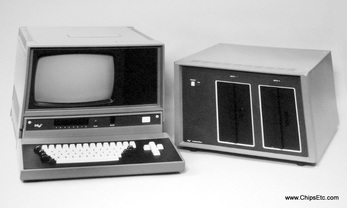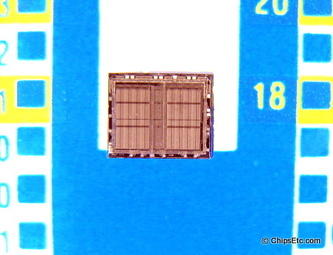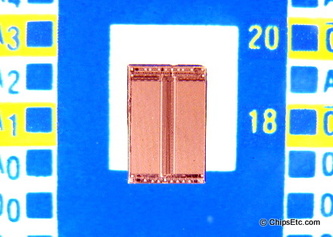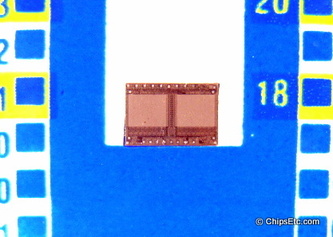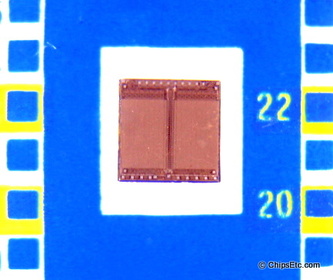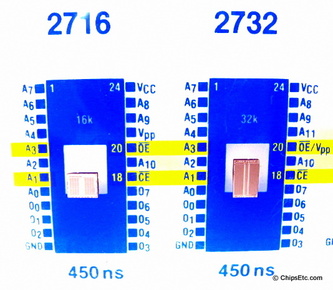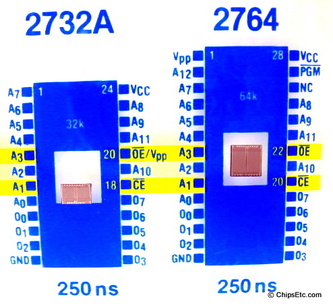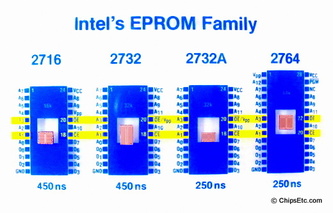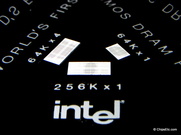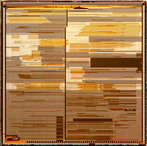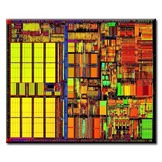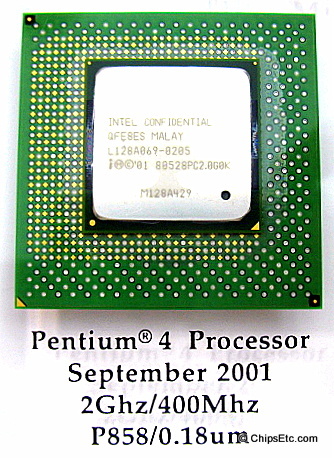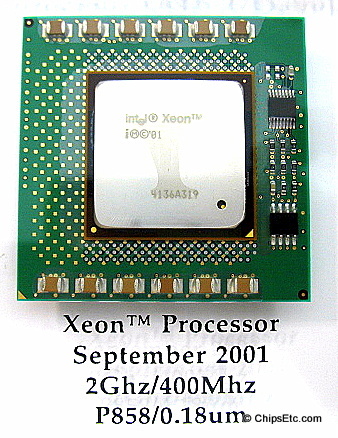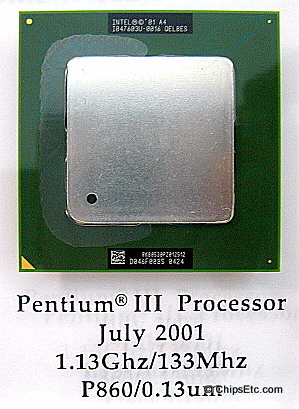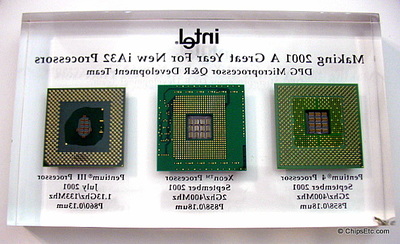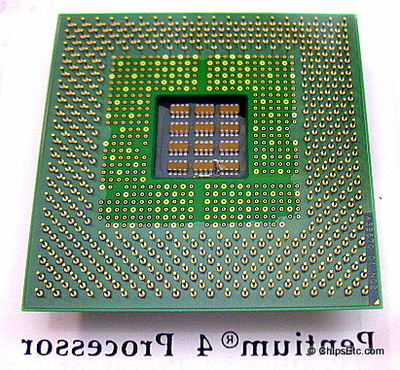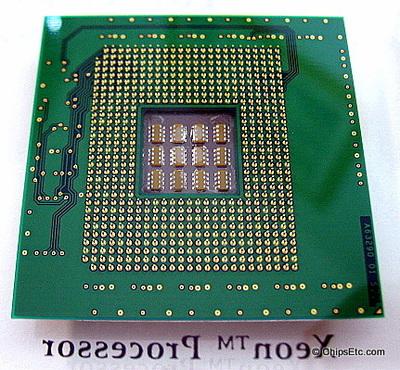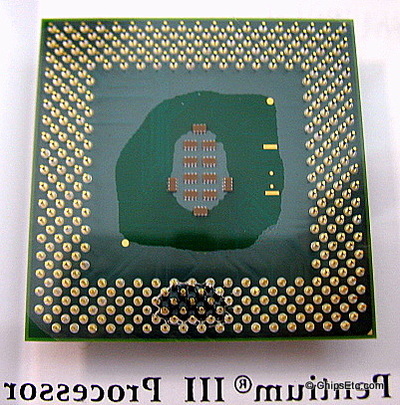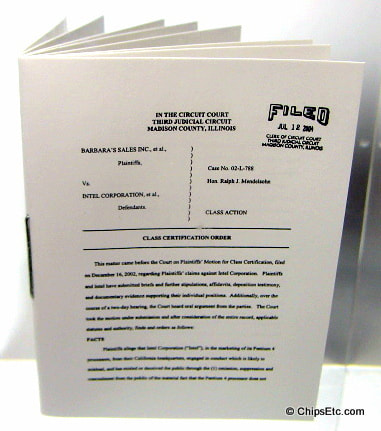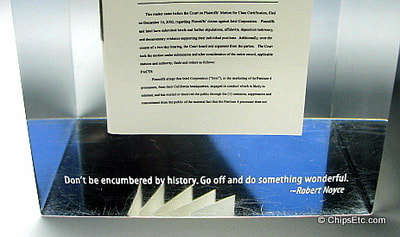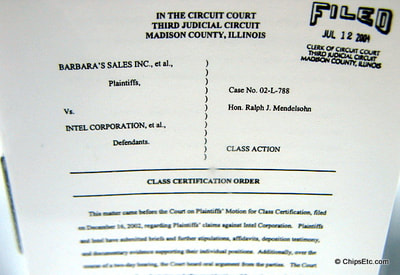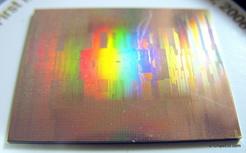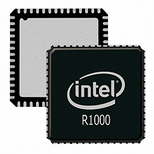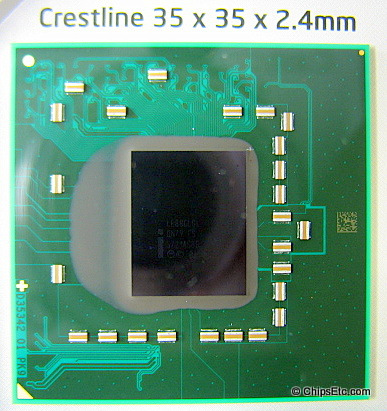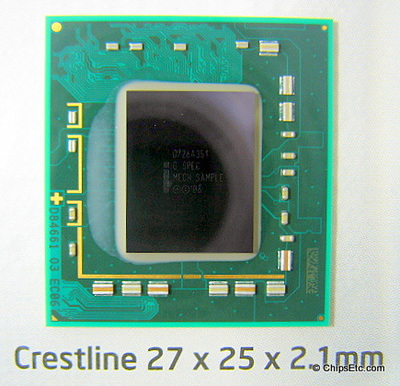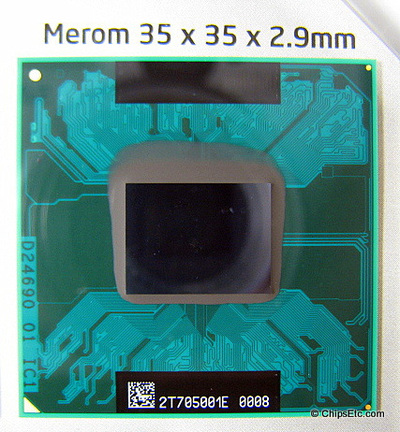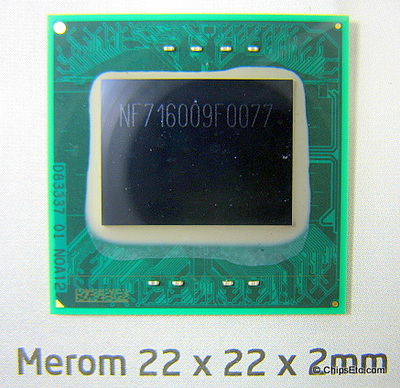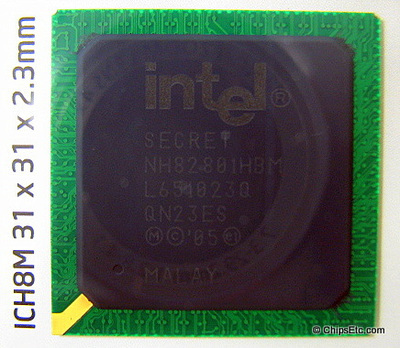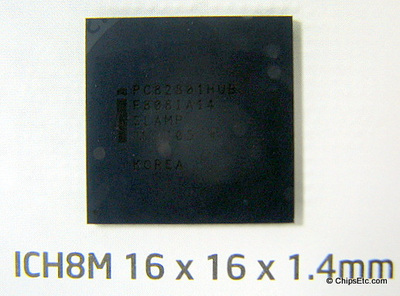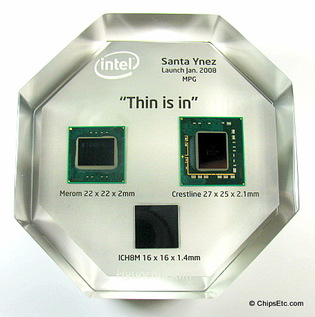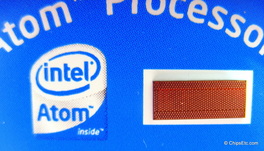Intel Paperweights
Intel INTELLEC MDS-800 Microcomputer Development System (1979)
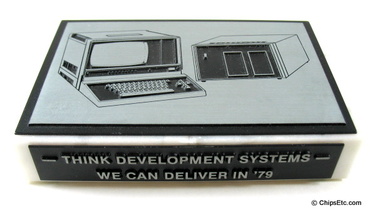
Item #465
The Intel Intelec MDS-800 system introduced by Intel in January 1979 was an early 8-bit computer system used mostly by OEM computer makers to design their 8080 CPU based computer systems. MDS stands for Microcomputer Development System. It used dual 8" floppy disk drives, the system had 32k memory card slot that was upgradeable to 2 cards for a total of 64k memory max, and was powered by an Intel 8080 Microprocessor.
This paperweight was given out to Intel internal MDS team members in 1979 to motivate increased deliveries of the MDS-800 systems to external developers.
White Marble paperweight features engraved metal showing the MDS-800 Computer Development system with monitor & Dual 8" Floppy Drive Module.
This paperweight was given out to Intel internal MDS team members in 1979 to motivate increased deliveries of the MDS-800 systems to external developers.
White Marble paperweight features engraved metal showing the MDS-800 Computer Development system with monitor & Dual 8" Floppy Drive Module.
Intel's EPROM Family: 2716, 2732, 2732A & 2764 (1981)
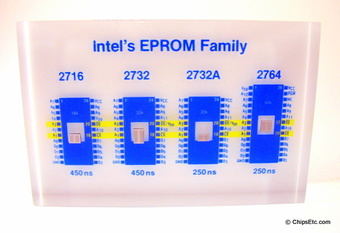
Item #471
This paperweight features the Intel 2700 series family of high-density EPROM memory chips embedded in Lucite. Descriptive text reads "Intel's EPROM Family" and shows the speed of each EPROM in nanoseconds.
The Intel 2700 series of EPROMs were ultraviolet erasable and electrically programmable read only memory, typically used in memory arrays for many early microcomputer systems.
The EPROM chips featured are:
Measures 3/4 x 4 1/2 x 3 in.
The Intel 2700 series of EPROMs were ultraviolet erasable and electrically programmable read only memory, typically used in memory arrays for many early microcomputer systems.
The EPROM chips featured are:
- Intel 2716 (16K bit 450ns NMOS EPROM) introduced 1977.
- Intel 2732 (32K bit 450ns NMOS EPROM) introduced in 1979.
- Intel 2732A (32K bit 250ns HMOS EPROM) introduced in 1980.
- Intel 2764 (64K bit 250ns HMOS EPROM) introduced in 1981.
Measures 3/4 x 4 1/2 x 3 in.
Intel World's First CHMOS DRAM Family (1984)
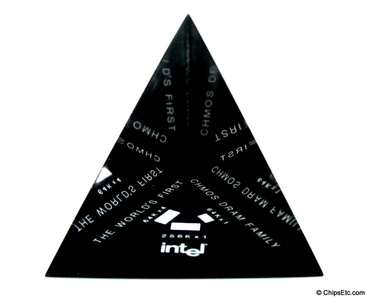
Item #485
This is a Lucite paperweight from Intel celebrating their lineup of CHMOS Dram Memory chips.
The base of the pyramid shaped paperweight is black and features descriptions around the base that identifies what each of the memory chips are.
The Intel DRAM chips featured in this piece are the Intel 64k x 4, 64k x 1 and 256k x 1.
Each side of this pyramid is 3-1/2" long.
The base of the pyramid shaped paperweight is black and features descriptions around the base that identifies what each of the memory chips are.
The Intel DRAM chips featured in this piece are the Intel 64k x 4, 64k x 1 and 256k x 1.
Each side of this pyramid is 3-1/2" long.
Intel Pentium Pro CPU & Memory (1995)
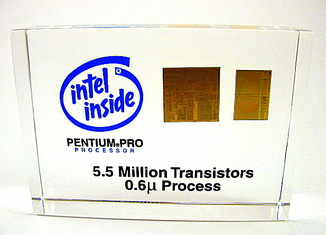
Item #262
The Pentium Pro was a sixth-generation X-86 based Microprocessor developed and manufactured by Intel. The P6 Architecture was originally intended to replace the original Pentium Processor in a full range of applications.
While the Pentium and Pentium MMX had 3.1 and 4.5 million transistors, the Pentium Pro contained 5.5 million transistors. Later, it was reduced to a more narrow role as a server and high-end desktop chip and was used in the Sandia Labs "ASCI Red" Supercomputer.
Lucite Paperweight contains a combination of both Core CPU and the Memory Chip for the .6 micron manufactured version of the Pentium Pro Microprocessor.
Measures 2 3/8" High x 3 3/8" Wide.
While the Pentium and Pentium MMX had 3.1 and 4.5 million transistors, the Pentium Pro contained 5.5 million transistors. Later, it was reduced to a more narrow role as a server and high-end desktop chip and was used in the Sandia Labs "ASCI Red" Supercomputer.
Lucite Paperweight contains a combination of both Core CPU and the Memory Chip for the .6 micron manufactured version of the Pentium Pro Microprocessor.
Measures 2 3/8" High x 3 3/8" Wide.
Intel Pentium III Chip Memo Holder (1999)
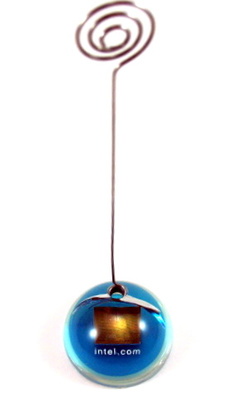
Item #085 (#100 & #135 similar)
Whimsical Acrylic Memo Holder with an actual Intel Pentium III Processor chip embedded inside.
Reads "Intel.com".
New in original package.
Reads "Intel.com".
New in original package.
Intel Pentium III / 4 / XEON 32-bit Sample Processors (2001)
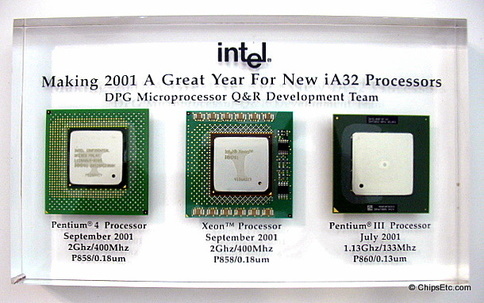
Item #886
Lucite paperweight given out to Intel's Desktop Platform Group (DPG) Quality & Reliability (Q&R) Development team members commemorating the release of three new versions of Intel iA32 32-bit Microprocessors in 2001:
Pentium 4 Desktop Processor
"Willamette"
September 2001
2Ghz clock / 400Mhz fsb
P858 process / 0.18um
Marked Intel Confidential
- Willamette was the first version of the Pentium 4 processor to be released.
Xeon Workstation / Server Processor
"Foster"
September 2001
2Ghz clock / 400Mhz fsb
P858 process / 0.18um
- Foster was the first of the Xeon branded processors to be released (earlier P6 versions were named Pentium Xeon).
Pentium III Desktop Processor
"Tualatin"
July 2001
1.13Ghz clock / 133Mhz fsb
P860 process / 0.13um
Marked ES (Engineering Sample)
- Tualatin was the last version of the Pentium III processors to be released.
Paperweight Reads: "Making 2001 a great year for new iA32 Processors - DPG Microprocessor Q&R Development Team". Measures 9" wide x 5" tall x 1" thick & has a small crack on the corner.
Pentium 4 Desktop Processor
"Willamette"
September 2001
2Ghz clock / 400Mhz fsb
P858 process / 0.18um
Marked Intel Confidential
- Willamette was the first version of the Pentium 4 processor to be released.
Xeon Workstation / Server Processor
"Foster"
September 2001
2Ghz clock / 400Mhz fsb
P858 process / 0.18um
- Foster was the first of the Xeon branded processors to be released (earlier P6 versions were named Pentium Xeon).
Pentium III Desktop Processor
"Tualatin"
July 2001
1.13Ghz clock / 133Mhz fsb
P860 process / 0.13um
Marked ES (Engineering Sample)
- Tualatin was the last version of the Pentium III processors to be released.
Paperweight Reads: "Making 2001 a great year for new iA32 Processors - DPG Microprocessor Q&R Development Team". Measures 9" wide x 5" tall x 1" thick & has a small crack on the corner.
Intel Pentium 4 Processor Class Action Lawsuit Paperweight (2004)
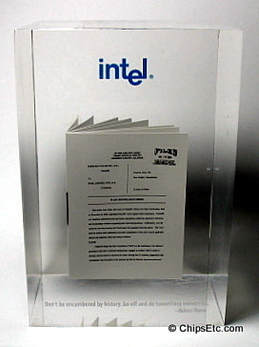
Item #973
Lucite paperweight from Intel's legal department features a miniature copy of the Class Certification Order issued by the court on July 12, 2004 for the case of Barbara's Sales Inc. vs. Intel Corporation.
The class action lawsuit originally filed in June 2002 accused Intel of misrepresenting the performance of their "Willamette" Pentium 4 processors.
In December 2007, an Illinois judge overturned a state appeals court ruling that would have launched a nationwide class-action lawsuit against Intel.
At the bottom of the paperweight is a quote from Intel founder Robert Noyce that Reads: "Don't be encumbered by history. Go off and do something wonderful."
The class action lawsuit originally filed in June 2002 accused Intel of misrepresenting the performance of their "Willamette" Pentium 4 processors.
In December 2007, an Illinois judge overturned a state appeals court ruling that would have launched a nationwide class-action lawsuit against Intel.
At the bottom of the paperweight is a quote from Intel founder Robert Noyce that Reads: "Don't be encumbered by history. Go off and do something wonderful."
Intel First Dual-Core Itanium Processor Paperweight (2006)
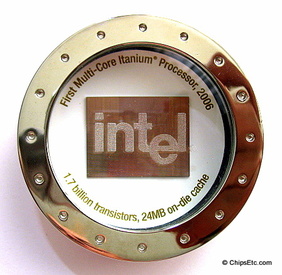
Item #818
Intel paperweight features an actual Itanium 64-bit processor chip displayed under removable glass lid with Polished steel case.
This version of the Itanium 2 processor known as Montecito, was the first Itanium processor to feature dual cores. It had 24MB of on-die L3 cache memory - 12MB on each core. It was manufactured using Intel's 90nm process and contained 1.7 Billion transistors.
Reads "First Multi-Core Itanium Processor".
This version of the Itanium 2 processor known as Montecito, was the first Itanium processor to feature dual cores. It had 24MB of on-die L3 cache memory - 12MB on each core. It was manufactured using Intel's 90nm process and contained 1.7 Billion transistors.
Reads "First Multi-Core Itanium Processor".
Intel First UHF RFID Transceiver R1000 Chip (2007)
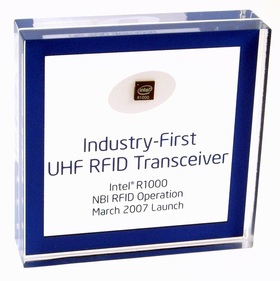
Lucite paperweight from Intel features the Industry's first UHF RFID Transceiver chip.
Intel's UHF RFID chip technology allowed for smaller and less expensive RFID readers, with longer ranger and faster read rates.
Intel's RFID chip operations (part of Intel's New Business Initiatives (NBI) division) were acquired by Impinj, Inc. in 2008.
Intel's UHF RFID chip technology allowed for smaller and less expensive RFID readers, with longer ranger and faster read rates.
Intel's RFID chip operations (part of Intel's New Business Initiatives (NBI) division) were acquired by Impinj, Inc. in 2008.
Intel Centrino Core 2 Duo Laptop Processor & Chipset Thinned Chips (2008)
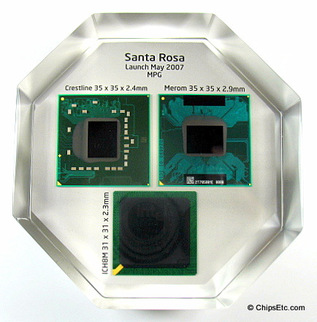
Item #900
This Octagonal Lucite paperweight from Intel's Mobile Platform Group (MPG) features a comparison of their Centrino brand Mobile processor and support chips after design improvements were implemented that greatly reduced their thickness and package size.
Chip samples include:
- Merom (Intel Core 2 Duo Mobile Processor)
- ICH8M (Intel Southbridge Mobile I/O Controller)
and on the other side:
- Merom (Intel Core 2 Duo Mobile Processor)
- ICH8M (Intel Southbridge Mobile I/O Controller)
Intel's 65nm Centrino mobile processors were competing for market share in the laptop segment against AMD's Turion 64 X2 Dual-Core mobile processor. The thinned "Santa Ynez" Centrino chips (nicknamed "mini-Merom" by the press) enabled OEM computer manufacturers to start offering "Ultra-Thin" laptops in 2008, such as the Apple MacBook Air and the IBM ThinkPad X300.
Most of the chips are marked either SECRET, MECH (Mechanical) SAMPLE, QS SPEC, or ES (for Engineering Sample).
Chip samples include:
- "Santa Rosa" Centrino Platform (May 2007 Launch)
- Merom (Intel Core 2 Duo Mobile Processor)
- ICH8M (Intel Southbridge Mobile I/O Controller)
and on the other side:
- "Santa Ynez" Centrino "Thinned" Platform (Jan 2008 Launch)
- Merom (Intel Core 2 Duo Mobile Processor)
- ICH8M (Intel Southbridge Mobile I/O Controller)
Intel's 65nm Centrino mobile processors were competing for market share in the laptop segment against AMD's Turion 64 X2 Dual-Core mobile processor. The thinned "Santa Ynez" Centrino chips (nicknamed "mini-Merom" by the press) enabled OEM computer manufacturers to start offering "Ultra-Thin" laptops in 2008, such as the Apple MacBook Air and the IBM ThinkPad X300.
Most of the chips are marked either SECRET, MECH (Mechanical) SAMPLE, QS SPEC, or ES (for Engineering Sample).
Intel ATOM Processor Chip Paperweight (2008)
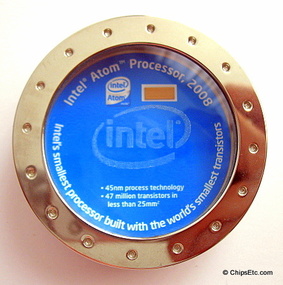
Item #817
An Intel paperweight featuring an actual first-generation ATOM processor chip.
The ATOM processor was an ultra-low-voltage 32-bit CPU designed for use in mobile internet devices and embedded applications. It was manufactured using Intel's 45nm CMOS process and contained 47 million transistors.
In 2012, Intel started offering 64-bit ATOM processors for use in servers.
Reads "Intel's smallest processor built with the world's smallest transistors". Paperweight features a removable glass lid with Polished steel case.
The ATOM processor was an ultra-low-voltage 32-bit CPU designed for use in mobile internet devices and embedded applications. It was manufactured using Intel's 45nm CMOS process and contained 47 million transistors.
In 2012, Intel started offering 64-bit ATOM processors for use in servers.
Reads "Intel's smallest processor built with the world's smallest transistors". Paperweight features a removable glass lid with Polished steel case.
